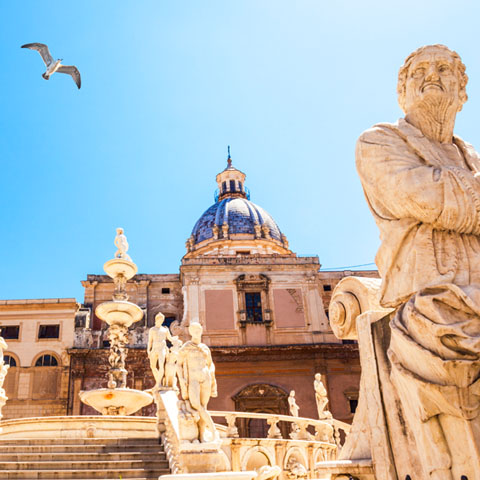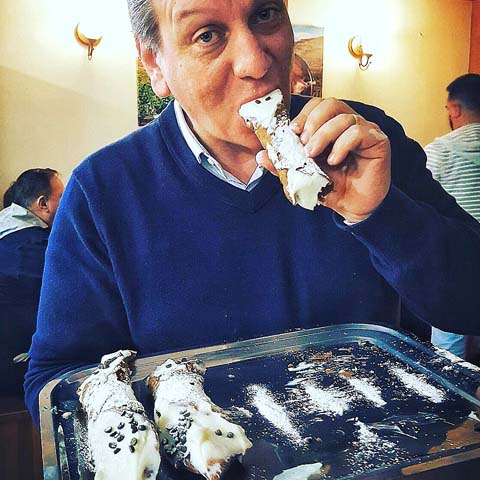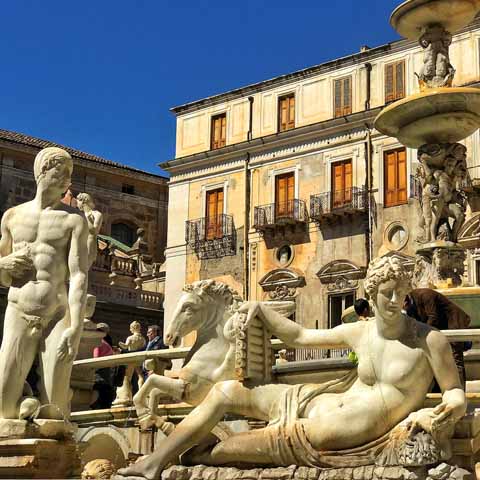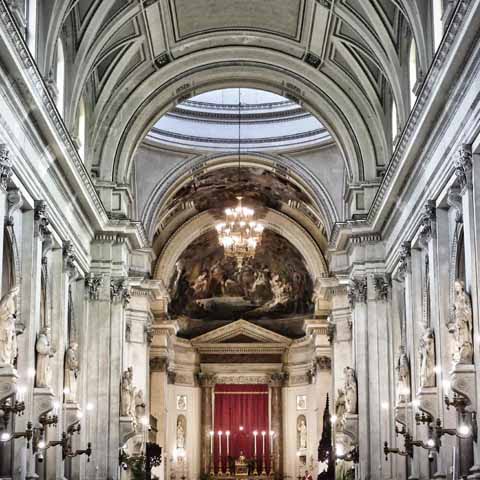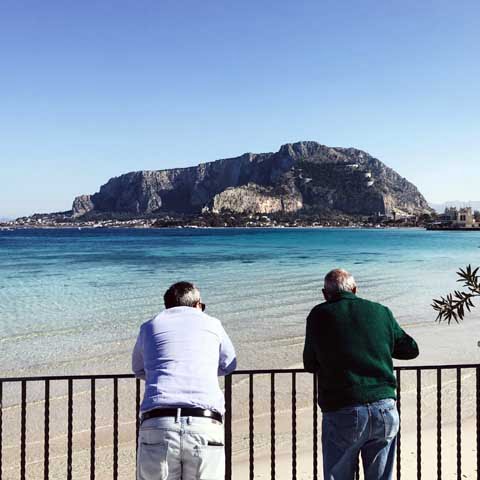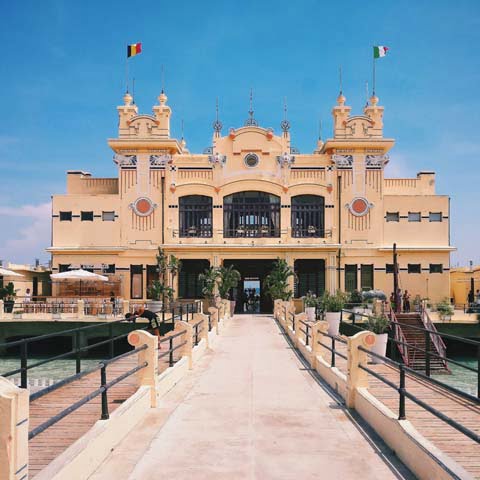The capital of Sicily, Palermo, is a treasure trove of history and culture. With influences from a variety of cultures – including Phoenician, Roman, Greek, Arab, Norman, and Spanish, just to name a few – Palermo is bursting with unique sights and activities to enjoy.
Whether visiting local festivities, trying Sicilian cuisine, or admiring the city’s many buildings and monuments, every day in Palermo has something exciting in store.
FESTIVAL AND EVENTS
One of the area’s most important events is the Festa di San Giuseppe, or Feast of Saint Joseph, which is held annually on March 19. During the festival, the most unique tradition is the vampa di San Giuseppe, when citizens burn items in a massive bonfire. The event is said to represent a rebirth during the new Spring season.
In July, Palermo locals celebrate their Patron Saint, Sant Rosalia, through a feast day. During this event, called Festa di Santa Rosalia, there is a procession with the saint’s relics, mass, fireworks, food, drink, and music.
In the small towns that are part of Palermo’s metropolitan area, countless fascinating local events are held annually. One of the most unique is the Festa degli Schietti, which takes place in the town of Terrasini on Easter. The protagonists of this festival are the town’s bachelors, the so-called schietti. The eligible bachelors compete in a competition where they must hold up an orange tree, typically weighing upwards of 100 lbs., in the palm of their hand. The man that raises up the tree to the highest point is declared the winner. Featuring historic clothing and delicious food, this event perfectly encapsulates the local culture.
Another notable example is the Ballo della Cordella in Petralia Sottana, which is held in August. This local festival with ancient roots consists of twelve local couples dressed in historic clothing that dance around a post while holding colorful ribbons. The post represents the tree of life, while the couples represent the twelve months of the year. As the couples dance around the post and cross paths, they create four figures with the ribbons that represent the stages of agriculture: plowing, sowing, germination, and harvest. As a peasant tradition, the festival began as a way to give thanks for the year’s harvest and bring good luck for future harvests.
In the town of Piana degli Albanesi the locals celebrate the arrival of Easter during Holy Week with several different events. The celebrations culminate on Easter Sunday when the local women participate in a procession while wearing ancient Greek Orthodox costumes. Following an ancient Greek-Byzantine custom, the procession ends with traditional red Easter eggs distributed to locals and tourists that symbolize life and fertility.
Also during Easter, a fascinating event takes place in the town of Prizzi called the Ballo dei Diavoli (Dance of the Devils). A mixture of sacred and profane, the event begins on Easter Sunday when Death, dressed in yellow, and the devils, dressed in red and wearing masks, attempt to capture the souls of the locals during a symbolic rite, but are thwarted by angels. As the rite unfolds, it becomes clear that the historic event was influenced by elements of Greek Tragedy.
OUTDOOR ACTIVITIES
Facing the Tyrrhenian Sea, Palermo is a coastal city that offers a variety of beach and water activities for travelers looking to enjoy the outdoors. The beaches vary from sandy to rocky, perfect for all types of beach activities.
In addition, Palermo has a mountain range that surrounds it, allowing travelers to enjoy hiking, mountain biking, and stunning views of the city and its bay. More adventurous travelers can even try freediving or skydiving.
To truly take in Palermo, travelers must take a walk along the main street of the capital city – historically called Cassaro, though its modern name is Via Vittorio Emanuele II. This ancient street runs all the way from the port to the south into the heart of the city. This path was historically the most important street in the city, and over the centuries it became more elegant, accumulating many historic buildings and monuments. Along the street, travelers can see Palermo’s Cathedral, the Palazzo dei Normanni, Piazza della Vittoria, and the Porta Nuova.
The second main artery of the historic city center is Via Maqueda; places of interest along this street include the Teatro Massimo and Piazza Pretoria with the Fontana Pretoria. Via Maqueda crosses Via Vittorio Emanuele II at the famed Quattro Canti (Four Corners, and also known as Piazza Vigliena). An expression of Palermo’s vast and multicultural history, the Quattro Canti is a prime location to visit. It is considered the heart of the city’s historic district and is surrounded by four corner buildings, each featuring beautiful decorations and statues.
Another street to walk in Palermo is Via Lincoln. It is located in the old portion of Palermo and along it, travelers can find the local botanical garden and Villa Giulia, a park dedicated to Giulia d’Avalos, the wife of Viceroy Marcantonio Colonna. Completed in 1777, the park is considered to be Italy’s first public park. In the center of the park, visitors will find a statue of Atlas holding up a solar clock that was designed by mathematician Lorenzo Federici.
On a beautiful day, consider visiting the Temple of Segesta, which is located in the province of Trapani about an hour drive from Palermo. A stunningly well-preserved fifth century Greek temple, the Temple of Segesta features 36 fully-intact columns and is surrounded by beautiful green hills.
The town squares are a great place to spend time outside while also soaking up the history and culture of Palermo. Piazza Della Vittoria and the largest square in the town, Piazza Marina, are both locales that go back centuries.
Among Palermo’s outdoor monuments, the Ancient Bathing Establishment of Mondello is considered to be one of Europe’s most remarkable examples of Art Nouveau architecture (called Liberty in Italy). Located in the beach area of Mondello, just north of Palermo, this elegant building is positioned on a platform suspended above the water. Its ornate architecture features friezes, sculptures, and colorful windows. Used during World War II as a military headquarters, the structure was eventually restored to its original splendor after the war.
Located in the Cuba-Calatafimi neighborhood of the city, Villa di Napoli is a seventeenth century villa that was originally a Norman palace. Found in the large Parco del Genoardo, the villa is positioned near two historic Norman structures. One is the Cuba, which was originally built in honor of King William II in 1180. Its initial purpose was to provide a place for the king and his court to recharge. The building is characterized by thick walls and only a few windows to provide shelter from the heat of the sun. The Cuba was featured in Boccaccio’s Decameron as the scene of a love story.
The other Norman monument in the Parco del Genoardo is the Cubola, which was also built under King William and completed in 1184. The structure was constructed on the site where the waters of Lake Alberira once flowed. Today the Cubola is considered to be part of Villa di Napoli.
Built in 1554 under the direction of esteemed sculptor Francesco Camilliani, the Praetorian Fountain was originally designed to decorate a villa in Florence. Ultimately, the fountain was purchased by the Palermo Senate and all 644 pieces were transported down to Sicily. Upon arrival, the fountain was put together following a new design. A truly beautiful monument, it was quite expensive to purchase and maintain, and among the locals it became a symbol of the corrupt local government. This, coupled with the nudity of the statues, led to the nickname “Fountain of Shame.”
The Admiral Bridge is one of the oldest and most important bridges of the city. Completed in 1140, the bridge once stood above the Oreto River, which was eventually redirected. Renowned for its architecture consisting of five arches, the bridge’s main claim to fame is that it is the exact location where Garibaldi and his troops defeated the Bourbon forces on the night of May 27, 1860.
Villa Bonanno is one of the local monuments that testifies to Palermo’s Roman Period. Located inside Piazza della Vittoria, Villa Bonanno houses the ruins of two Roman residences that date back to the fourth century BC. The ruins were discovered by chance in 1868 and today they capture the attention of Palermo’s many international travelers.
INDOOR ACTIVITIES
One of the most stunning structures to explore in Palermo is the Cathedral. Built in the early 1000s, the Cathedral is dedicated to Our Lady of the Assumption. Though it has been reconstructed and altered throughout history, its many architectural influences – Byzantine, Islamic, Christian, Gothic, and Neo-Classical – are visible today and provide a visual history of the city. The interior is filled with stunning architectural details, artworks, sacred vestments, royal tombs, and the chapel housing the elegant silver urn of Santa Rosalia.
After the Cathedral, the most stunning religious building in Palermo is, without a doubt, the Capella Palatina (Palatine Chapel). Located inside the Palazzo dei Normanni, the seat of power for the Normans and subsequent rules of Italy, the beauty of the Palatine Chapel is sure to conquer all who visit it. Construction of the chapel was completed in 1143, and in the words of French author Guy de Maupassant, the Palatine Chapel is “the most beautiful religious jewel ever dreamed by human thought.” The floors of the chapel are decorated with what art historians consider to be some of the best Byzantine mosaics still visible today. The walls and ceiling feature intricate gold mosaics that must be seen to be believed. On the ceiling, visitors will also find Islamic muqarnas, an unlikely yet beautiful addition to the Catholic chapel.
If the gold mosaics of the Palatine Chapel caught your attention, be sure to spend some time in nearby Monreale to visit the Cathedral of Monreale. Positioned above Palermo, this thirteenth century church is renowned for its distinct architecture and remarkable mosaics.
Also worth a visit is the Basilica of the Santissima Trinità, which is one of the last architectural examples of the Norman Age in Sicily. After undergoing an expansion in the fifteenth century, the exterior of the church was radically changed during the Baroque
Era when it was covered with plaster. Subsequent restorations at the end of the nineteenth and beginning of the twentieth century sought to return the church to its Norman appearance. Today the church features a Baroque doorway and several elements of the Gothic style, including arches and colonnades.
The Basilica of San Francesco d’Assisi is one of Palermo’s most important thirteenth century structures. Featuring Gothic and Baroque architecture as well as Renaissance style chapels, the church is a perfect place to admire the fusion of Sicily’s historic architectural styles. The art collection of the church is vast, featuring works by Antonio Scaglione, Antonello Gagini, Pietro Novelli, and many more.
Other churches to see in Palermo include the Church of San Giovanni degli Eremiti – a wonderful example of Arab architecture, the Church of San Pietro e San Paolo – a nineteenth century church with Gothic elements and a wooden pulpit created by Salvatore Valenti, and the Church of Carmine Maggiore – a church which features a decorative façade and a beautiful dome.
To truly admire the eclectic nature of Palermo’s history, visit the Palazzina Cinese, or Chinese Palace. Built in the late 1700s, the palace features a unique combination of Chinese, Gothic, Arab, and Egyptian elements.
For an in-depth look at historical objects, Palermo’s Museo Archeologico Regionale, or Archeological Museum, holds a variety of historic treasures. From objects to sculptures to mosaics and more, the museum is a marvelous place to explore Palermo’s history.
To take in a show, the Teatro Massimo is a must. It is the biggest theater in Italy and one of Europe’s largest. It was built in the late 1800s and features a frescoed ceiling by artist Giovanni Battista Filippo Basile. It hosts operas, concerts, and shows throughout the year.
However, the oldest theater in Palermo is Teatro Bellini, which was constructed in 1726, though its origins date back to 1676. Originally, it was known as Teatro Travaglino, a small theater that took its name from Palermo’s Commedia dell’Arte character. Today the theater is open for tours and intends to stage productions again in the future.
Another historic theater is the Teatro Politeama, which was built during the second half of the nineteenth century. Home to the Orchestra Sinfonica Siciliana, it is the second most important theater in Palermo next to the Massimo. It, too, hosts operas and concerts.
Just outside of Palermo’s city limits, curious travelers will find the Paleo Christian Catacombs of Porta D’Ossuna. Believed to have been constructed between the fourth and fifth century AD, the catacombs were not discovered until 1739. Covering a distance of several hundred feet, the catacombs feature tunnels and corridors as well as a vestibule commissioned by Ferdinand I of Bourbon. In more recent history, the catacombs were used as a shelter during World War II bombing.
SHOPPING
The most important and historic market in Palermo is the Ballarò market. Its history dates back to the eleventh century and it is considered to be the oldest food market in the city. At the market, travelers can explore the maze of booths to see local fruit, vegetables, grain, and other food products.
Other important historic markets in the city include Capo, Vucciria, and Borgo Vecchio. Immersing oneself in the chaos and vitality of these markets is one of the best ways to truly experience the local culture.
UNIQUE EXPERIENCES
An intriguing experience to have in Palermo is a visit to the Catacombe dei Cappuccini, or the Catacombs of the Capuchin Friars. In these catacombs, which date to the sixteenth century, more than 1,200 mummies, including adults and children are housed. The catacombs are organized by the person’s gender, profession, and social status. The original clothes of the people are still visible too. The original purpose of the catacombs was to honor dead Capuchin friars and serve as a reminder to the living that death is a part of life. The final burials occurred in the 1920s, and today the natural mummies of the Capuchin Catacombs welcome curious travelers from all over the world.
Unlike any other museum in town, the Museo Internazionale delle Marionette is home to one of the world’s biggest collections of puppets. It houses over 3,500 puppets, marionettes, and shadow puppets. The museum is also part of the Festival di Morgana, an event in which puppet shows of Sicily’s Opera dei Pupi tradition are performed in theaters throughout the region.
The historic city of Palermo offers plenty of traditional events, outdoor activities, indoor monuments, and unique experiences for travelers with a variety of interests. From the breathtaking art to the high concentration of historic architectural styles, Palermo is the perfect destination for your next cultural immersion.
Don't just see Italy, live it.
Your dream trip to Italy has never been closer
No more endlessly scrolling travel sites. Our travel experts will craft the perfect, one-of-a-kind trip just for you.

300+
DESTINATIONS
We offer more Italian destinations than any travel site. Do and see more with Trips 2 Italy.
1 (of a kind)
ITINERARIES
Because your dream trip to Italy should be designed for you, not for the masses.
100%
PEACE OF MIND
From flights and accommodations, to food and activities - we take care of every detail.
